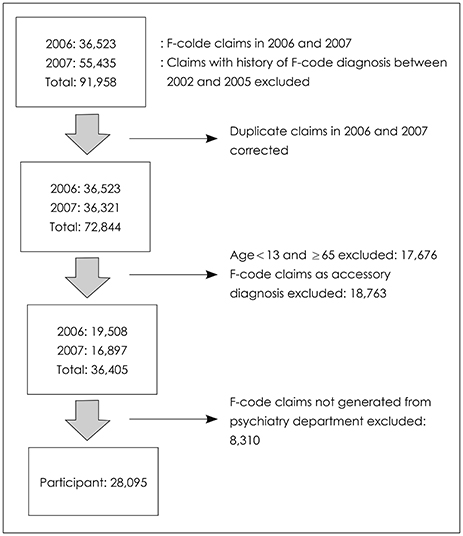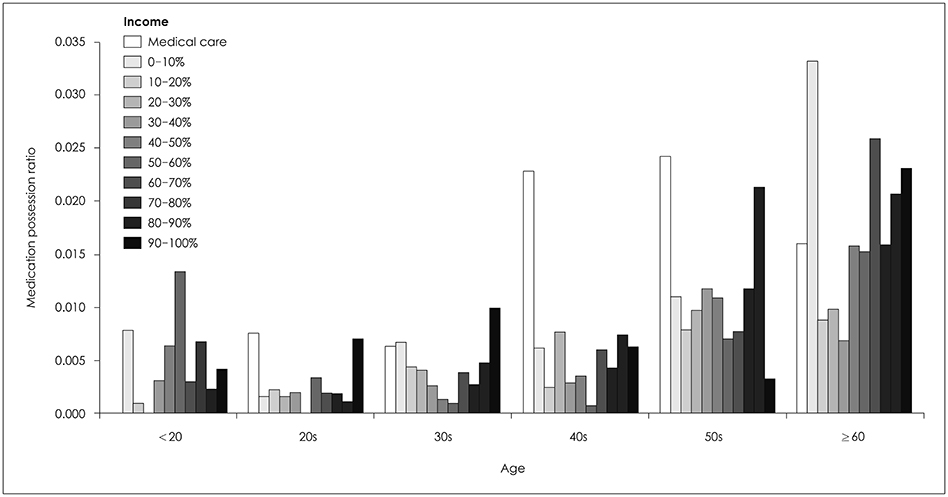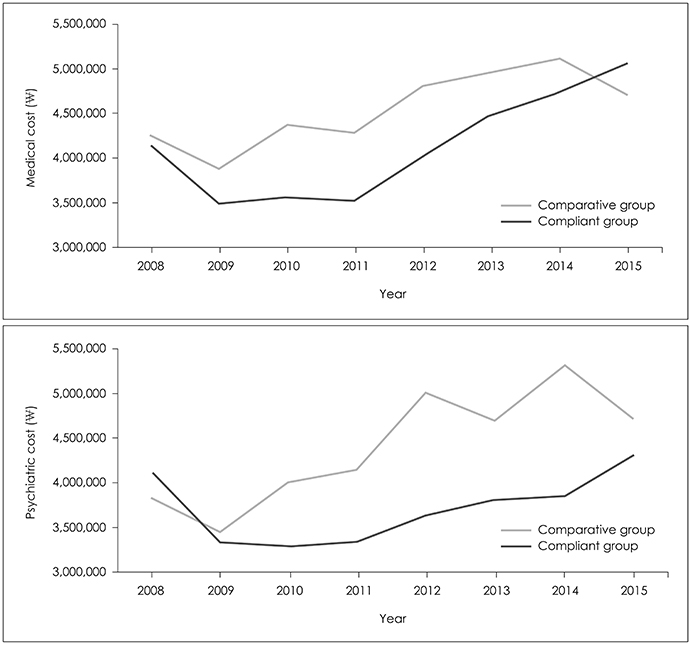Korean J Schizophr Res.
2019 Oct;22(2):42-50. 10.16946/kjsr.2019.22.2.42.
Clinical Characteristics, Drug Adherence to Antipsychotics and Medical Use Trends in Patients First Diagnosed with Psychotic Disorder: A Preliminary Study
- Affiliations
-
- 1Department of Psychiatry, National Health Insurance Service Ilsan Hospital, Goyang, Korea. psy.ilsan@nhimc.or.kr
- 2Department of Policy Research Affairs, National Health Insurance Service Ilsan Hospital, Goyang, Korea.
- 3Department of Psychiatry and Institute of Behavioral Science in Medicine, Yonsei University College of Medicine, Seoul, Korea.
- 4Yonsei Hana Psychiatry Clinic and Institute of Mental Health, Goyang, Korea.
- KMID: 2462051
- DOI: http://doi.org/10.16946/kjsr.2019.22.2.42
Abstract
OBJECTIVES
In this preliminary study, we investigated the clinical characteristics of patients who were first diagnosed with psychotic disorder and explored the impact of the adherence to antipsychotics on long-term medical use.
METHODS
All national health insurance claims related to psychotic disorders including gender, age, income, and drug compliance, from January 1, 2008 to December 31, 2015, were examined. With trend test using Medication Possession Ratio (MPR), we compared the medical use between the compliant group (MRP≥0.8) and the comparative non-compliant group (0.2≤MPR<0.8).
RESULTS
Among 28,095 participants in total, 16,239 patients (57.8%) were diagnosed as schizophrenia; the 30s were the most common (n=7,151, 25.5%). Drug compliance was generally low regardless of the diagnosis and was the lowest among 20s with the 40-60% range of income. The compliant group showed lower psychiatric and medical use than the comparative group in the following years (p<0.0001).
CONCLUSION
These findings suggest that patients in the 20s and 30s with the 40-60% range of income, who are diagnosed with schizophrenia at the first psychiatric visit, may need more clinical and political attention. The results also emphasize the importance of initial drug adherence to antipsychotics in reducing long-term psychiatric costs.
MeSH Terms
Figure
Cited by 2 articles
-
Pseudo-Resistant Schizophrenia: Non-Adherence to Treatment
Hyerim Kim, Seung Jae Lee
Korean J Schizophr Res. 2020;23(2):51-57. doi: 10.16946/kjsr.2020.23.2.51.One-Year Clinical Outcomes After Diagnosis According to Early Medication Adherence in First-Episode Schizophrenia: A Nationwide, Health Insurance Data-Based Retrospective Cohort Study
Woohyeok Choi, Sung Woo Joo, Soojin Ahn, Young Jae Choi, Sun Min Kim, Jungsun Lee
Korean J Schizophr Res. 2023;26(1):24-31. doi: 10.16946/kjsr.2023.26.1.24.
Reference
-
1. American Psychiatric Association. Diagnostic and statistical manual of mental disorders. 5th ed. Hakjisa;2013. p. 93–94.2. National Collaborating Centre for Mental Health. National Institute for Health and Clinical Excellence: Guidance. Psychosis and Schizophrenia in Adults: Treatment and Management: Updated Edition 2014. London: National Institute for Health and Care Excellence (UK);2014. p. 14–15.3. Keshavan MS, Nasrallah HA, Tandon R. Schizophrenia, “Just the Facts” 6. Moving ahead with the schizophrenia concept: from the elephant to the mouse. Schizophr Res. 2011; 127:3–13.
Article5. Kreyenbuhl J, Buchanan RW, Dickerson FB, Dixon LB. The schizophrenia patient outcomes research team (PORT): updated treatment recommendations. 2009. Schizophr Bull. 2010; 36:94–103.
Article6. Hasan A, Falkai P, Wobrock T, Lieberman J, Glenthoj B, Gattaz WF, et al. World Federation of Societies of Biological Psychiatry (WFSBP) Guidelines for biological treatment of schizophrenia, Part 1: Update 2012 on the acute treatment of schizophrenia and the management of treatment resistance. World J Biol Psychiatry. 2012; 13:318–378.
Article8. Klosterkötter J, Hellmich M, Steinmeyer EM, Schultze-Lutter F. Diagnosing schizophrenia in the initial prodromal phase. Arch Gen Psychiatry. 2001; 58:158–164.
Article9. Falkenberg I, Valmaggia L, Byrnes M, Frascarelli M, Jones C, Rocchetti C, et al. Why are help-seeking subjects at ultra-high risk for psychosis help-seeking? Psychiatry Res. 2015; 228:808–815.
Article10. Simon GE, Stewart C, Hunkeler EM, Yarborough BJ, Lynch F, Coleman KJ, et al. Care pathways prior to first diagnosis of psychotic disorder in adolescents and young adults. Am J Psychiatry. 2018; 175:434–442.
Article11. Marshall M, Rathbone J. Early intervention for psychosis. Schizophr Bull. 2011; 37:1111–1114.
Article12. Kim HG, Kang SH, Cheon EJ. Clinical staging and early intervention in psychiatry. J Korean Soc Biol Ther Psychiatry. 2016; 22:67–83.13. McGorry PD, Killackey E, Yung A. Early intervention in psychosis: concepts, evidence and future directions. World Psychiatry. 2008; 7:148–156.
Article14. Mihalopoulos C, Harris M, Henry L, Harrigan S, McGorry P. Is early intervention in psychosis cost-effective over the long term? Schizophr Bull. 2009; 35:909–918.
Article15. McGorry PD, Nelson B, Amminger GP, Bechdolf A, Francey SM, Berger G, et al. Intervention in individuals at ultra-high risk for psychosis: a review and future directions. J Clin Psychiatry. 2009; 70:1206–1212.16. Morrison AP, French P, Walford L, Lewis SW, Kilcommons A, Green J, et al. Cognitive therapy for the prevention of psychosis in people at ultra-high risk. Br J Psychiatry. 2004; 185:291–297.
Article17. Park JI, Jeon M. The stigma of mental illness in Korea. J Korean Neuropsychiatr Assoc. 2016; 55:299–309.
Article18. Kim JH, Seo MK. Comparing prejudice and discrimination according to types of mental disorder: using vignettes. Ment Health Soc Work. 2011; 37:35–64.19. Kane JM, Marder SR. Psychopharmacologic treatment of schizophrenia. Schizophr Bull. 1993; 19:287–302.
Article20. Dixon LB, Lehman AF, Levine J. Conventional antipsychotic medications for schizophrenia. Schizophr Bull. 1995; 21:567–577.
Article21. Leucht S, Tardy M, Komossa K, Heres S, Kissling W, Salanti G, et al. Antipsychotic drugs versus placebo for relapse prevention in schizophrenia: a systematic review and meta-analysis. Lancet. 2012; 379:2063–2071.
Article22. Tiihonen J, Wahlbeck K, Lönnqvist J, Klaukka T, Ioannidis JPA, Volavka J, et al. Effectiveness of antipsychotic treatments in a nationwide cohort of patients in community care after first hospitalisation due to schizophrenia and schizoaffective disorder: observational follow-up study. BMJ. 2006; 333:224.
Article23. Geddes J, Freemantle N, Harrison P, Bebbington P. Atypical antipsychotics in the treatment of schizophrenia: systematic overview and meta-regression analysis. BMJ. 2000; 321:1371–1376.
Article24. Weiden PJ, Olfson M. Cost of relapse in schizophrenia. Schizophr Bull. 1995; 21:419–429.
Article25. Valenstein M, Copeland LA, Blow FC, McCarthy JF, Zeber JE, Gillon L, et al. Pharmacy data identify poorly adherent patients with schizophrenia at increased risk for admission. Med Care. 2002; 40:630–639.
Article26. Terkelsen KG, Menikoff A. Measuring the costs of schizophrenia: implications for the post-institutional era in the US. Pharmacoeconomics. 1995; 8:199–222.27. Velligan DI, Weiden PJ, Sajatovic M, Scott J, Carpenter D, Ross R, et al. The expert consensus guideline series: adherence problems in patients with serious and persistent mental illness. J Clin Psychiatry. 2009; 70 Suppl 4:1–46.28. Morken G, Widen JH, Grawe RW. Non-adherence to antipsychotic medication, relapse and rehospitalisation in recent-onset schizophrenia. BMC Psychiatry. 2008; 8:32.
Article29. Correll CU, Manu P, Olshanskiy V, Napolitano B, Kane JM, Malhotra AK. Cardiometabolic risk of second-generation antipsychotic medications during first-time use in children and adolescents. JAMA. 2009; 302:1765–1773.
Article30. Newcomer JW. Second-generation (atypical) antipsychotics and metabolic effects. CNS Drugs. 2005; 19:1–93.
Article31. Szmulewicz AG, Angriman F, Pedroso FE, Vazquez C, Martino DJ. Long-term antipsychotic use and major cardiovascular events: a retrospective cohort study. J Clin Psychiatry. 2017; 78:e905–e912.32. Newcomer JW, Hennekens CH. Severe mental illness and risk of cardiovascular disease. JAMA. 2007; 298:1794–1796.
Article33. Casey DE. Metabolic issues and cardiovascular disease in patients with psychiatric disorders. Am J Med. 2005; 118 Suppl 2:15S–22S.
Article34. Sajatovica M, Velliganb DI, Weidenc PJ, Valensteind MA, Ogedegbee G. Measurement of psychiatric treatment adherence. J Psychosom Res. 2010; 69:591–599.
Article35. Ascher-Svanum H, Faries DE, Zhu B, Ernst FR, Swartz MS, Swanson JW. Medication adherence and long-term functional outcomes in the treatment of schizophrenia in usual care. J Clin Psychiatry. 2006; 67:453–460.
Article36. Valenstein M, Blow FC, Copeland LA, McCarthy JF, Zeber JE, Gillon L, et al. Poor antipsychotic adherence among patients with schizophrenia: medication and patient factors. Schizophr Bull. 2004; 30:255–264.
Article37. Krousel-Wood M, Islam T, Webber LS, Re R, Morisky DE, Muntner P. New medication adherence scale versus pharmacy fill rates in hypertensive seniors. Am J Manag Care. 2009; 15:59–66.38. Huybrechts KF, Ishak KJ, Caro JJ. Assessment of compliance with osteoporosis treatment and its consequences in a managed care population. Bone. 2006; 38:922–928.
Article39. Andrade SE, Kahler KH, Frech F, Chan KA. Methods for evaluation of medication adherence and persistence using automated databases. Pharmacoepidemiol Drug Saf. 2006; 15:565–574.
Article40. Häfner H, Maurer K, Löffler W, Riecher-Rössler A. The influence of age and sex on the onset and early course of schizophrenia. Br J Psychiatry. 1993; 162:80–86.
Article41. Kendler KS. Demography of paranoid psychosis (delusional disorder). Arch Gen Psychiatry. 1982; 39:890–902.
Article
- Full Text Links
- Actions
-
Cited
- CITED
-
- Close
- Share
- Similar articles
-
- Use of Atypical Antipsychotics in Psychotic Disorder and Behavioral Disorder Caused by physical Disease
- The Drug Adherence and Treatment Effect of the Paliperidone Long Acting Injection
- The Rationale and Effect of Antipsychotics Combination Therapy
- The Characteristics and Treatments of Major Depressive Disorder with Psychotic Features
- A Case of Narcissistic Personality Disorder with Brief Psychotic Episode




